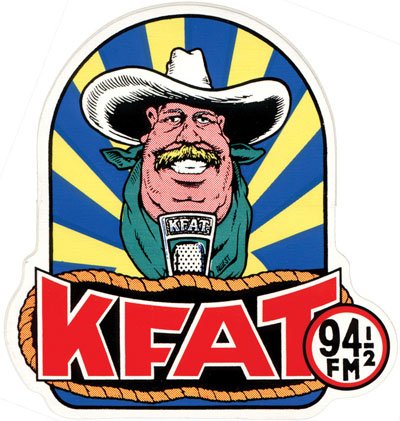It’s been 36 years since KFAT vanished into thin air. Yet utter
these two syllables and locals who spent their youthful heydays in
the Bay Area will tilt their heads in thought, squint their eyes as
they tap into the good vibrations of a fading libertine subculture,
then grin at the memory of a radio station with rockabilly roots
and anti-establishment moxie that still resonates with the
listeners who relished its airwaves.
It’s been 36 years since KFAT vanished into thin air. Yet utter these two syllables and locals who spent their youthful heydays in the Bay Area will tilt their heads in thought, squint their eyes as they tap into the good vibrations of a fading libertine subculture, then grin at the memory of a radio station with rockabilly roots and anti-establishment moxie that still resonates with the listeners who relished its airwaves.
“People today don’t have any clue what this kind of radio was like,” lamented former KFAT disc jockey alumnus Gilbert Klein.
“What they get now is corporate rock and corporate country. This was the antithesis of any kind of format.”
Klein maintains KFAT was the birthplace of the Americana genre.
Nashville, he insisted, had no idea there was a revolution in country music under way.
“It was happening in Gilroy.”
He chatted away in feverish reminiscence of the station’s glory days.
“The musicians back in the day all revered KFAT,” he said, name-dropping blues legend John Lee Hooker, along with Neil Young – who Klein said often called in with requests and “thanked us on an album cover.”
Apple co-founder Steve Wozniak, too, was a fan.
“Music is a very important part of my life, and I credit most of that to what I discovered when I discovered KFAT, back when I was designing the early Apple Computers,” wrote Wozniak in a March 16 e-mail. “To this day I constantly tell people how my music ‘center’ came from those days. I constantly search out the sort of music KFAT played. It was so different, yet so good, musically and lyrically and comically.”
Wozniak, who created US Festivals – two post-Woodstock music and culture events that took place in the 1980s – said he attributes his musical interest to KFAT “more than any other thing” – including iPods and satellite radio.
“The stations I listen to these days, and the concerts I go to, I’m looking for the same thing,” he wrote. “I’m always listening to esoteric and ‘out there’ stations on my car radio and get to concerts about once a week to catch a lot of great lesser known groups.”
For Gilroy, KFAT was the nucleus of an epoch; “the last gasp of the 60s,” as Klein describes it – a beatnik, blue-collar, grassroots, renegade radio station run by “misfits, rejects, ne-‘er-do-wells” and a couple anarchists following “the promise of free laundry.”
Inside the station “carpets were threadbare, the walls were moldy, the equipment was antiquated, the town smelled of garlic, and the checks were bouncing. Everything there was cheap,” he said. “If you jumped in the wrong place, or there was an errant blast of wind, it might take the station off the air.”
With his inextinguishable zeal, Klein, who lives in Mexico, is the unofficial torchbearer for the infamous radio station which went off the air in 1983. He’s written an unpublished book documenting the radical revolution of resonance taking place in that grungy, kickback studio – 23 steps upstairs on Monterey Street in what used to be the Old Gilroy Hotel.
KFAT is the stuff of subculture legend.
The origins of tradition
This glorious hole-in-the wall originally located above what is now the Vacuum Center of Gilroy, played an integral role in establishing the fundamental pillars of identity on which Gilroy stands: The city’s slogan, “Garlic Capital of the World,” and the Garlic Festival.
The first story begins with a DJ named Karl Hess, who provided “the Morning Nudes” to KFAT listeners.
One day, Klein writes, Hess decided to create an ID for KFAT that would “at least sound like he was proud of this cultural backwater.” Hess remembered a rickety four-by-six-foot sign that once stood along a windy stretch of Highway 101 near a cluster of fruit and vegetable stands “decades ago,” which had all but faded by the mid ’70s and was no longer recognizable.
Klein said the sign was located on a somewhat treacherous stretch of road nicknamed “Blood Alley,” so many a white-knuckled driver drove pass without noticing “Gilroy’s little message to the world.”
After retreating to the production room and returning with a record by the U.S. Navy Choral, Hess revived the slogan set to a musical backdrop of “America the Beautiful.”
“This is KFAT, Gilroy,” he said, slowly raising his voice to a profound boom. “The Garlic … Capital …of the WORLD.”
Jocks loved it, Klein said; so did representatives from the City of Gilroy.
The rest is history.
KFAT’s other not-so-well-known contribution to city history began with a phone call from Karen Christopher, former wife of garlic mogul Don Christopher who owns Christopher Ranch in Gilroy.
What KFAT head honcho Laura Ellen thought it would be another complaint from an offended listener ruffled by the station’s edgy music, turned out to be a polite request for a little assistance with public relations.
“Mrs. Christopher had been a part of a recent series of discussions among her garlic-growing ladyfriends in town regarding the promotion of Gilroy garlic,” wrote Klein.
The potential picnic, party or festival – as it was still in the works – “would be a celebration of their uncelebrated but essential crop.”
The event was advertised only through KFAT, which eventually assumed responsibility for booking musicians, renting and setting up the stage area and – most importantly – locking down a beer distributor.
Soon, Klein said, KFAT was promoting the day as the ‘Gilroy Garlic Festival,’ inviting its listeners to come down that Sunday, eat some garlic, listen to music and meet the KFAT jocks and “other fatheads.”
Originally, Mrs. Christopher and company had planned for a modest turnout of 300 to 400 people.
Klein said afterward it was estimated between 8,000 and 12,000 people showed up, and the booth selling KFAT T-shirts sold out in 15 minutes.
“The parking guy had since abandoned any hope of order,” he noted. “KFAT is long gone, but the Gilroy Garlic Festival endures, with music, garlic-saturated food and good cheer, as it should.”
The motley crew
The indie radio station’s relationship with the rest of Gilroy wasn’t comparable, say, to the kind of reception the syndicated radio show “Delilah, Love Someone” gets.
“We were alone down there,” said Klein of when KFAT first moved to Gilroy in 1975.
When Ellen threw a big breakfast bash and invited every merchant in town, Klein said, Gary Steinmetz – the owner of an old bar called the Green Hut – was the only person who showed up.
“We were hippies,” he proclaimed like it was a beautiful affliction. “We freaked them out.”
No doubt, the crew ran with some interesting company.
Mark Keen, who worked for a competing station called Radio KEEN back in the day and now runs an advertising agency in San Jose, said the station never sold commercially as well as it should have despite many listeners – some of the closet variety.
“You didn’t see a lot of people in Cadillacs listening to KFAT,” he chuckled. “It’s kind of like driving an old car – a lot of fun, but you don’t want anybody to see you.”
KFAT received threats and occasional visits from the FBI Klein said. Hells Angels called it their official station and “came by to party – a bunch of times” and the Ku Klux Klan stopped by to hang out and “make a programming suggestion.”
He said they left their business card.
“It’s in the book.”
There was also the occasional person looking for a place to spend the night …”or a hooker,” and the “muffin tin twins” – a pair of 19-year-olds from East Bay who showed up with a muffin tin, each concavity filled with a different psychotropic treat.
Keen said it was usual to see a guy in a KFAT shirt and assume he was “smoking dope.”
“It appealed to anybody that wasn’t ‘normal,’ ” he said. “They considered themselves a little out of the fringe. People like that were welcome there; they felt comfortable and could be themselves.”
As Klein delved into a story of how the CIA tried to interfere in his talk show and sabotage a radio interview with a an ex-agent named Jim Hougan who dissented and wrote a book called “Spooks” – which leaked a slew of classified information – the tale became borderline conspiracy-theorist.
“We both got a call from the CIA pretending to be somebody else, saying the interview had been canceled,” he recalled.
Klein said the two later reconnected and realized they had been messed with.
“I knew Gilbert back in the day,” said Sam Van Zandt, currently a DJ for KBAY in San Francisco who worked for KPER, the station that eventually became KFAT.
When KFAT took over, he said, it was a phenomenon – short-lived, but a phenomenon, nonetheless.
“I’ve heard stories of a guy falling asleep on the turntable with a loaded gun in hand,” he laughed. “People were afraid to wake him.”
Sweet sounds, open minds
Despite its outer facade of eccentric characters and cockeyed shenanigans, KFAT had some serious street credibility when it came to musical ingenuity and taste.
“Musicians would stop by and marvel at the library,” said Klein. “They knew the obscure music KFAT played. They all considered KFAT a national treasure.”
RJ Dyer, a local realtor who rented out the upstairs space of the Old Gilroy Hotel to KFAT in 1975, said he and his buddies would go out in a boat and listen to KFAT tapes.
“It was a great, great station,” he remembered. “And Gilroy’s own.”
When RJ’s son Rick Dyer moved to Gilroy at age 22 and told his friends where he was living, their first comments were, “that’s where KFAT is!”
“It was kinda cosmic country,” he said. “You just didn’t hear this music anywhere else, not even today. Even my friends in Half Moon Bay had heard of it.”
Rick said KFAT’s refusal to convert to commercial format was its greatest quality – and its own death certificate.
“Everybody knew it was going to die,” he said. “It was just a question of time.”
Keen credits KFAT as the unsung hero that rode into town and heightened awareness of Gilroy; a largely uncredited promotional entity that put the Garlic Capital and surrounding areas on the map.
With most stations nowadays, he pointed out, the time and tempo is tightly formatted.
“You can’t just go into a radio station with a record anymore, listen to it, like it and then play it,” he said in a nod of reverence to the innovative sensation that once was.
“That’s what the fun of what radio used to be, and it’s still like that at KPIG,” said Keen. “KFAT was the start of all that.”
The Renaissance
In the past months there have been whispers of a KFAT revival festival that could be held in downtown Gilroy according to local developer Gary Walton. In a perfect scenario, the event would be timed with the publishing of Klein’s book.
But the publishing road hasn’t been smooth. Klein, who is still in search of an investor, cited a series of fickle and flaky editors, not to mention the pesky recession.
“I want it in print, but I also want world peace, a trunk full of fifties and a girlfriend named Lola,” he wrote in a recent e-mail.
He said the manuscript has been ready to publish for so long now, he might just put it out as an e-book.
Eric Howard, president of the Gilroy Downtown Business Association, said there’s plenty of interest in a KFAT festival. It’s just a matter of securing a point person to make it happen, he said.
Festival or not, KFAT’s legacy remains larger than its brief but rockin’ life.
T-shirts still sell on eBay, online chat forums buzz with memories, and now and then, a fading bumper sticker will appear on an old Westfalia camper van parked outside a record store.
An underground, near-cultish following still exists.
“I still see people wearing KFAT t-shirts,” said Keen. “I’ve seen people that have boxes of stickers and pass them out at events.”
It was the embodiment of an attitude; a lifestyle – the sound that kept people company while they were driving at night, a voice that commiserated, refused to reform, united a mishmash of listeners from various backgrounds and ignited enthusiasm for the deliciousness of music in its purest form: Gritty, uncensored and fresh off the album as it was intended to be heard.
Maybe that’s why KFAT will never die.














